
|
Great outburst occured on Oct. 24, and it bacame a naked eye comet of 2 mag. It still keeps so bright as 4.7 mag on Mar. 5 (Seiichi Yoshida). It will be visible with naked eyes for a while in the dark sky. However, it became hard to see and reported so faint as 5-6 mag without an excellent sky condition. It was completely stellar just after the outburst. Then the coma had spread out and now it looks like a huge nebula. The coma diameter has increased up to about 90 arcmin in December and January. But now it is going away from the earth, and the diameter reduced to about 70 arcmin. It will be getting lower gradually in the evening sky after this. The altitude will be lower than 30 degrees in late April.
Date(TT) R.A. (2000) Decl. Delta r Elong. m1 Best Time(A, h)
Mar. 15 4 10.21 37 22.4 3.163 3.037 73 4.9 19:43 (145, 6)
Mar. 22 4 20.63 37 6.9 3.282 3.067 68 5.0 19:32 (143, 5)
|
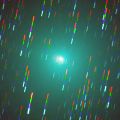
|
It passed near by Earth in early January, and it became a bright large object at 5.4 mag (Jan. 3, Seiichi Yoshida). It was visible with naked eyes. Now it is fading. But the fading is slower than originally predicted, and it is still bright as 7.8 mag (Mar. 18, Marco Goiato). It has already moved away towards the southern sky, and it is no longer observable in the Northern Hemisphere. In the Southern Hemisphere, it keeps observable until it fades out.
Date(TT) R.A. (2000) Decl. Delta r Elong. m1 Best Time(A, h)
Mar. 15 4 3.31 -57 18.0 1.057 1.255 75 8.2 19:43 ( 40, 51)
Mar. 22 4 20.33 -58 38.7 1.107 1.315 77 8.7 19:32 ( 38, 51)
|

|
It brightened up to 8.3 mag on Feb. 6 (Juan Jose Gonzalez). Now it is fading, but still bright as 9.8 mag (Mar. 16, Marco Goiato). In the Northern Hemisphere, it keeps observable in good condition until July when it becomes fainter than 18 mag. It will be visible visually until early May.
Date(TT) R.A. (2000) Decl. Delta r Elong. m1 Best Time(A, h)
Mar. 15 4 20.79 30 54.4 0.985 1.194 74 9.4 19:43 (143, 12)
Mar. 22 4 57.73 33 4.4 1.028 1.238 75 9.8 19:32 (148, 13)
|
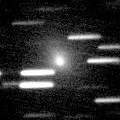
|
New bright comet discovered by two Chinese amateurs. Now it is very bright as 10.3 mag (Mar. 5, Seiichi Yoshida). Diffuse object with a weak condensation. It keeps 10 mag until May. In the Northern Hemisphere, it keeps observable in good condition in the evening sky until mid May. But then it moves southwards, and it will never be observable again. In the Southern Hemisphere, it appears in late March, then it keeps observable until it fades out.
Date(TT) R.A. (2000) Decl. Delta r Elong. m1 Best Time(A, h)
Mar. 15 3 35.33 47 19.8 1.302 1.358 71 10.2 19:43 (146, -6)
Mar. 22 4 8.83 42 16.9 1.312 1.322 68 10.1 19:32 (145, 0)
|
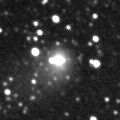
|
Now it is bright as 11.5 mag (Mar. 17, Marco Goiato). It will keep 11 mag for a long time until August. In the Southern Hemisphere, it keeps observable in good condition until summer. In the Northern Hemisphere, it had been locating extremely low for a long time, however, it will be getting higher gradually after March. But the altitude will never be higher than 30 degrees in the evening sky, and the comet will be unobservable in July. It will appear in the morning sky again at 13 mag at the end of 2008, then it keeps bright and observable for a while.
Date(TT) R.A. (2000) Decl. Delta r Elong. m1 Best Time(A, h)
Mar. 15 9 25.98 -44 22.3 2.309 2.989 124 11.4 21:52 ( 0, 81)
Mar. 22 9 25.27 -42 1.7 2.276 2.963 125 11.3 21:24 ( 0, 83)
|

|
It brightened up to 8.5 mag on Jan. 6 (Alexandre Amorim). Now it is fading gradually, but still bright as 10.9 mag (Mar. 16, Marco Goiato). It became observable also in the Northern Hemisphere again since late February. It keeps observable while fading gradually until May. It keeps brighter than 13 mag within March. But it will be hard to see visually after April.
Date(TT) R.A. (2000) Decl. Delta r Elong. m1 Best Time(A, h)
Mar. 15 6 2.70 -23 7.9 1.429 1.801 94 11.8 19:43 (123, 70)
Mar. 22 6 7.23 -16 31.0 1.594 1.887 90 12.3 19:32 (129, 63)
|
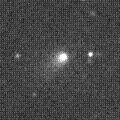
|
It brightened already up to 11.4 mag (Mar. 17, Marco Goiato). It will pass 0.85 A.U. from the sun in late June, and it is expected to reach to 6 mag. In the Northern Hemipshere, it keeps observable in good condition for a long time after this, while the comet is brightening gradually. It is observable until around May 25, when the comet will be 7.5 mag. It will be unobservable for one and a half month around the perihelion passage. But it will appear in the morning sky again at 7 mag in early July, then it keeps observable after that while the comet is fading gradually. In the Southern Hemipsphere, it keeps observable all the period until the comet fades out, although it will be low in mid June.
Date(TT) R.A. (2000) Decl. Delta r Elong. m1 Best Time(A, h)
Mar. 15 12 37.99 -14 57.1 0.953 1.911 157 12.7 1:08 (180, 70)
Mar. 22 12 30.48 -15 56.1 0.841 1.819 163 12.2 0:33 (180, 71)
|

|
Now it is 15.3 mag (Mar. 8, Ken-ichi Kadota). Now it is brightening rapidly. However, it is fainter than this ephemeris by 2 mag so far. It is expected to reach to 13 mag in March and April, and to be visible visually. But actually, it may be fainter than expected. It keeps observable in good condition for a long time in the Southern Hemisphere. In the Northern Hemisphre, it keeps locating low until March. But it will be getting higher after April and observable while the comet is fading.
Date(TT) R.A. (2000) Decl. Delta r Elong. m1 Best Time(A, h)
Mar. 15 17 47.01 -29 5.6 0.565 1.122 87 12.8 4:34 (262, 68)
Mar. 22 18 20.08 -23 25.9 0.559 1.117 87 12.7 4:40 (249, 65)
|
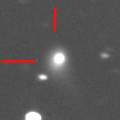
|
It brightened up to 13.5 mag and became visible visually in 2007 autumn (Nov. 13, Juan Jose Gonzalez). It will reach to 10.5 mag and will be observable in good condition in 2008 autumn. Now it is not observable. But it will appear in the morning sky at 12.5 mag in May, then it keeps observable, visible visually, brighter than 14 mag for one year until 2009 May.
Date(TT) R.A. (2000) Decl. Delta r Elong. m1 Best Time(A, h)
Mar. 15 23 14.56 10 20.6 4.096 3.141 14 13.0 4:34 (271,-20)
Mar. 22 23 24.29 11 53.3 4.046 3.095 15 12.9 4:40 (267,-16)
|

|
It is already visible visually at 13.5 mag (Mar. 7, Michael Mattiazzo). It is expected to be 7 mag in September. But it keeps moving in the southern sky, so it is difficult to see in the Northern Hemisphere. It will be locating in the very low sky at about 10 degree high until mid March, then it becomes unobservable in the Northern Hemisphere. It will appear in the evening sky at 7 mag in late September, but it keeps locating in the evening low sky until the end of 2008 when it fades out down to 10 mag. Then it turns to appear in the morning sky, and it keeps observable in the northern sky after that while fading gradually. In the Southern Hemisphere, it keeps observable until late October after this.
Date(TT) R.A. (2000) Decl. Delta r Elong. m1 Best Time(A, h)
Mar. 15 5 14.34 -39 59.4 2.972 3.027 83 13.2 19:43 ( 69, 65)
Mar. 22 5 12.32 -38 59.7 2.953 2.948 80 13.0 19:32 ( 71, 62)
|

|
The return of a comet discovered in 2003 by SOHO spacecraft. It can be a short periodic comet with a period of about 4 years. If so, it is expected to return in 2008 spring. If it passes the perihelion in spring, it will be visible at 12-15 mag in the evening sky. But the period is quite uncertain with an error of several months. So we have to wait until it is re-discovered by chance.
Date(TT) R.A. (2000) Decl. Delta r Elong. m1 Best Time(A, h)
Mar. 15 2 10.94 4 35.1 0.991 0.650 38 13.2 19:43 (102, 9)
Mar. 22 3 5.69 8 38.2 0.958 0.756 45 14.1 19:32 (112, 14)
|

|
After an outburst on Dec. 29, some outbursts occured repeatedly until mid January. It became very bright as 10.4 mag on Jan. 15 (P. Clay Sherrod). Then it is fading gradually. But it is still bright as 12.7 mag on Mar. 5 (Juan Jose Gonzalez).
Date(TT) R.A. (2000) Decl. Delta r Elong. m1 Best Time(A, h)
Mar. 15 5 50.06 29 0.2 5.868 6.005 93 13.7 19:43 (160, 23)
Mar. 22 5 52.14 28 50.6 5.982 6.007 86 13.7 19:32 (156, 22)
|
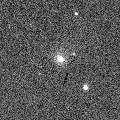
|
Now it is visible visually at 14.4 mag (Mar. 5, Seiichi Yoshida). It will reach to 13.5 mag until July. It keeps observable in good condition for a long time until May.
Date(TT) R.A. (2000) Decl. Delta r Elong. m1 Best Time(A, h)
Mar. 15 12 36.31 5 41.6 2.389 3.361 165 13.9 1:06 (180, 49)
Mar. 22 12 31.30 5 16.7 2.342 3.330 171 13.8 0:33 (180, 50)
|
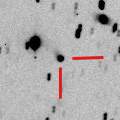
|
Now it is 15.0 mag (Feb. 24, Ken-ichi Kadota). It will be bright at 12 mag for a long time from 2008 spring to 2009 spring. It was not visible visually, fainter than 13.9 mag, on Mar. 5 (Seiichi Yoshida), but it must become visible visually soon. However, it is only observable until August in the Northern Hemisphere because the comet moves southwards. It keeps observable for a long time in the Southern Hemisphere.
Date(TT) R.A. (2000) Decl. Delta r Elong. m1 Best Time(A, h)
Mar. 15 18 18.53 -4 8.6 3.690 3.658 80 14.0 4:34 (233, 46)
Mar. 22 18 20.16 -4 43.8 3.532 3.611 86 13.8 4:40 (224, 52)
|

|
It will reach to 11 mag in summer. It must have already brightened up to 14 mag, but the comet was not observed recently. The condition in this apparition is bad. In the Southern Hemisphere, it keeps extremely low, or under the horizon, so it will not be observable. In the Northern Hemisphere, it is not observable until August when it appears in the morning sky at 11 mag. After August, it keeps observable and fading in the morning sky.
Date(TT) R.A. (2000) Decl. Delta r Elong. m1 Best Time(A, h)
Mar. 15 0 5.17 -21 30.3 2.864 1.961 20 14.1 19:43 ( 63, -1)
Mar. 22 0 21.42 -19 25.9 2.814 1.912 20 13.9 19:32 ( 64, -3)
|

|
It was 15 mag on Jan. 14 (Michael Mattiazzo), brightening as expected. It will reach to 13.5 mag in the southern sky in spring and summer. In the Southern Hemisphere, it keeps observable for a long time after this. But in the Northern Hemisphere, it is already unobservable. It will be observable again at the end of 2008, when the comet will already fade down to 15 mag.
Date(TT) R.A. (2000) Decl. Delta r Elong. m1 Best Time(A, h)
Mar. 15 1 57.42 -44 31.1 3.145 2.653 52 14.2 19:43 ( 55, 31)
Mar. 22 2 12.88 -44 20.2 3.103 2.628 53 14.2 19:32 ( 55, 30)
|

|
Appearing in the morning sky. It shoudl be already bright as 14.5 mag. It will be getting higher gradually after this, and will be observable at 14 mag in good condition from spring to summer. It will also be visible visually.
Date(TT) R.A. (2000) Decl. Delta r Elong. m1 Best Time(A, h)
Mar. 15 19 40.34 -19 57.1 2.390 2.100 61 14.6 4:34 (267, 41)
Mar. 22 19 56.56 -18 23.8 2.316 2.084 64 14.5 4:40 (262, 43)
|

|
It brightned up to 13.4 mag on Jan. 4 (Seiichi Yoshida). Now it is fading, but still visible visually at 14.4 mag (Mar. 5, Seiichi Yoshida). It will be too low to observe in the evening sky at 16 mag in June.
Date(TT) R.A. (2000) Decl. Delta r Elong. m1 Best Time(A, h)
Mar. 15 7 43.97 14 16.3 2.177 2.814 120 14.7 20:10 (180, 41)
Mar. 22 7 48.16 13 58.0 2.278 2.841 114 14.8 19:47 (180, 41)
|
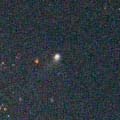
|
Now it is 13.9 mag (Mar. 5, Seiichi Yoshida). It keeps observable visually at 14 mag at high location for a while.
Date(TT) R.A. (2000) Decl. Delta r Elong. m1 Best Time(A, h)
Mar. 15 17 9.02 10 7.6 5.382 5.610 98 14.7 4:34 (202, 42)
Mar. 22 17 5.74 11 20.5 5.279 5.614 104 14.7 4:40 (189, 43)
|

|
Peculiar asteroid moving on a cometary orbit. Now it is brightest at 14.3 mag (Mar. 5, Seiichi Yoshida). It has passed the perihelion in late January, but still completely asteroidal. It keeps 15 mag until March. In the Northern Hemisphere, it keeps observable until July when it becomes fainter than 18 mag. Although already going away from the sun, it may show a cometary activity after this.
Date(TT) R.A. (2000) Decl. Delta r Elong. m1 Best Time(A, h)
Mar. 15 10 20.70 -15 2.8 0.925 1.870 153 15.0 22:47 (180, 70)
Mar. 22 10 23.65 -11 15.9 0.954 1.894 152 15.1 22:22 (180, 66)
|
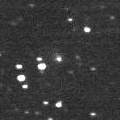
|
It is already bright as 14.7 mag and visible visually (Mar. 5, Seiichi Yoshida). It is expected to reach to 11 mag in 2009 summer. Because it moves in the northern sky, it keeps observable until it becomes brightest in the Northern Hemisphere.
Date(TT) R.A. (2000) Decl. Delta r Elong. m1 Best Time(A, h)
Mar. 15 3 9.43 57 5.6 5.596 5.380 72 15.2 19:43 (150,-16)
Mar. 22 3 10.11 56 41.5 5.643 5.333 67 15.2 19:32 (148,-17)
|
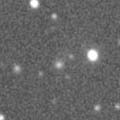
|
It was observed at 16 mag in 2007 spring and summer. In the Southern Hemisphere, it keeps 15-16 mag and observable in good condition until summer. In the Northern Hemisphere, it will never be observable again. No observations have been reported recently, and the current brightness is uncertain.
Date(TT) R.A. (2000) Decl. Delta r Elong. m1 Best Time(A, h)
Mar. 15 19 29.86 -50 12.1 3.070 2.906 71 15.3 4:34 (309, 50)
Mar. 22 19 43.76 -50 12.6 3.028 2.935 75 15.3 4:40 (309, 53)
|
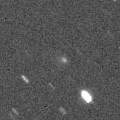
|
It brightened up to 13.4 mag on Jan. 4 (Seiichi Yoshida). It tends to be brightest after the perihelion passage. But now it is already fading. It has already faded down to 15.9 mag (Feb. 25, Mitsunori Tsumura). It is observable until April when it becomes too low at 17 mag.
Date(TT) R.A. (2000) Decl. Delta r Elong. m1 Best Time(A, h)
Mar. 15 2 18.92 17 0.3 2.404 1.816 43 15.6 19:43 (113, 3)
Mar. 22 2 35.76 19 22.3 2.496 1.866 41 15.9 19:32 (115, 1)
|

|
It reached to 12.7 mag on Dec. 4 (Juan Jose Gonzalez). Now it is fading slowly. But it is still bright and visible visually at 13.5 mag (Mar. 5, Seiichi Yoshida). However, it will be fading and getting lower very rapidly after April.
Date(TT) R.A. (2000) Decl. Delta r Elong. m1 Best Time(A, h)
Mar. 15 4 27.95 32 29.8 1.908 1.926 75 15.7 19:43 (145, 12)
Mar. 22 4 47.16 32 24.6 2.001 1.959 73 15.9 19:32 (145, 12)
|
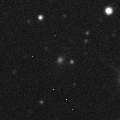
|
It brightened up to 14.5 mag on Jan. 4 and became visible visually (Seiichi Yoshida). Now it is fading. It has already faded down to 16.2 mag (Mar. 9, Ken-ichi Kadota). It will be too low at 17 mag in June.
Date(TT) R.A. (2000) Decl. Delta r Elong. m1 Best Time(A, h)
Mar. 15 5 32.70 23 25.2 2.311 2.501 89 16.0 19:43 (153, 27)
Mar. 22 5 41.78 23 4.6 2.402 2.505 84 16.1 19:32 (151, 26)
|

|
Now it is 16.1 mag (Mar. 9, Ken-ichi Kadota), brightened as expected. It will reach to 16 mag from February to April, and will be observable in good condition.
Date(TT) R.A. (2000) Decl. Delta r Elong. m1 Best Time(A, h)
Mar. 15 9 30.81 47 28.1 0.718 1.536 126 16.0 21:56 (180, 8)
Mar. 22 9 22.47 42 12.3 0.718 1.516 123 16.0 21:21 (180, 13)
|

|
Now it is 17.3 mag (Jan. 26, J. Manteca, A. Sanchez). It is brighter than originally expected by 1 mag. It will be observable at 15.5-16 mag from April to July. It will be fainter than 18 mag in late August. It keeps locating in the evening sky all time.
Date(TT) R.A. (2000) Decl. Delta r Elong. m1 Best Time(A, h)
Mar. 15 6 56.78 21 32.3 0.853 1.502 108 16.4 19:43 (175, 33)
Mar. 22 7 3.57 21 3.6 0.863 1.459 103 16.3 19:32 (172, 34)
|

|
Now it is 16.8 mag (Feb. 29, Ken-ichi Kadota). It keeps 16 mag for one year from 2008 spring to 2009 spring. In the Northern Hemisphere, it keeps observable in good condition while the comet is brightening until 2008 spring. But the comet moves southwards after that, and it will never observable after 2008 July.
Date(TT) R.A. (2000) Decl. Delta r Elong. m1 Best Time(A, h)
Mar. 15 12 4.20 11 32.3 3.304 4.284 168 16.4 0:34 (180, 43)
Mar. 22 11 54.99 11 8.3 3.271 4.250 167 16.4 23:52 (180, 44)
|

|
Now it is 16.4 mag (Mar. 7, Ken-ichi Kadota), brightening as expected. It keeps observable at 16.5 mag in good condition until April.
Date(TT) R.A. (2000) Decl. Delta r Elong. m1 Best Time(A, h)
Mar. 15 12 35.13 6 58.0 1.403 2.379 165 16.6 1:05 (180, 48)
Mar. 22 12 30.13 7 42.4 1.420 2.407 169 16.7 0:32 (180, 47)
|

|
Now it is 16.7 mag (Feb. 16, Ken-ichi Kadota), brightened as expected. It will be observable in good condition for a hile until spring. It will reach to 16.5 mag in March.
Date(TT) R.A. (2000) Decl. Delta r Elong. m1 Best Time(A, h)
Mar. 15 10 36.12 36 7.0 1.648 2.514 142 16.6 23:02 (180, 19)
Mar. 22 10 32.27 36 4.7 1.681 2.506 137 16.6 22:30 (180, 19)
|
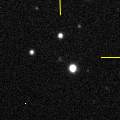
|
It will reach to 15 mag in 2009 and 2010. Now it is 16.5 mag (Dec. 18, J. R. Vidal). It will be observable at 16.5 mag in good condition until March.
Date(TT) R.A. (2000) Decl. Delta r Elong. m1 Best Time(A, h)
Mar. 15 4 58.39 24 13.7 3.946 3.921 81 16.8 19:43 (146, 22)
Mar. 22 5 3.37 24 24.3 4.042 3.913 75 16.9 19:32 (144, 21)
|
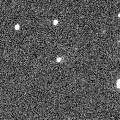
|
Now it is 17.2 mag (Mar. 8, Ken-ichi Kadota). Around the aphelion, but it is observable at 17 mag in good condition. It will reach to 13 mag in 2010.
Date(TT) R.A. (2000) Decl. Delta r Elong. m1 Best Time(A, h)
Mar. 15 8 10.31 31 5.0 3.537 4.159 122 17.0 20:36 (180, 24)
Mar. 22 8 9.07 30 56.3 3.614 4.144 115 17.0 20:08 (180, 24)
|

|
It was visible visually at 14.6 mag on Jan. 4 (Seiichi Yoshida). Now it is already fading. It has already faded down to 17.2 mag (Feb. 28, Mitsunori Tsumura). It keeps observable in good condition for a while, but it will be fainter than 18 mag in April.
Date(TT) R.A. (2000) Decl. Delta r Elong. m1 Best Time(A, h)
Mar. 15 4 34.72 41 3.2 2.224 2.258 79 17.3 19:43 (151, 6)
Mar. 22 4 51.31 40 41.1 2.325 2.289 75 17.4 19:32 (151, 6)
|

|
It will be observable at 17.5 mag in good condition until May.
Date(TT) R.A. (2000) Decl. Delta r Elong. m1 Best Time(A, h)
Mar. 15 7 56.94 39 42.4 3.540 4.090 117 17.4 20:23 (180, 15)
Mar. 22 7 57.36 40 6.5 3.625 4.082 110 17.4 19:56 (180, 15)
|
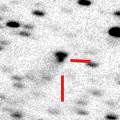
|
It was observed at 16.5-17 mag in 2006 and 2007. Because it is a very distant comet, it is observable at 17 mag still in 2008 in good condition.
Date(TT) R.A. (2000) Decl. Delta r Elong. m1 Best Time(A, h)
Mar. 15 19 47.34 26 35.8 6.479 6.093 63 17.4 4:34 (228, 9)
Mar. 22 19 47.91 27 51.4 6.421 6.107 67 17.4 4:40 (222, 13)
|

|
It had been observed at 16.5 mag for a long time from 2005 to 2007. Now it is fading. But it keeps observable at 17.5 mag in good condition for a long time until July.
Date(TT) R.A. (2000) Decl. Delta r Elong. m1 Best Time(A, h)
Mar. 15 14 30.08 16 10.4 7.620 8.363 135 17.5 2:59 (180, 39)
Mar. 22 14 27.33 16 16.3 7.588 8.388 141 17.5 2:29 (180, 39)
|

|
It was recovered at 18.7 mag on Mar. 3, as bright as expected (R. E. Hill). It will brighten rapidly after this, and reach to 15 mag in May. In the Southern Hemisphere, it keeps observable in good condition until it fades out. In the Northern Hemisphere, the condition is bad. It will be too low to observe in mid May.
Date(TT) R.A. (2000) Decl. Delta r Elong. m1 Best Time(A, h)
Mar. 15 16 31.90 23 46.2 0.669 1.347 106 17.9 4:34 (187, 31)
Mar. 22 16 54.47 22 58.4 0.598 1.297 106 17.5 4:40 (184, 32)
|

|
Now it is 17.7 mag (Dec. 15, Ken-ichi Kadota). Because it is a very distant comet, it keeps observable at 17.5-18 mag until 2009.
Date(TT) R.A. (2000) Decl. Delta r Elong. m1 Best Time(A, h)
Mar. 15 11 1.82 1 43.3 7.950 8.931 170 17.5 23:27 (180, 53)
Mar. 22 11 0.24 2 11.4 7.980 8.939 163 17.5 22:58 (180, 53)
|

|
It will be observable at 17.5-18 mag until March.
Date(TT) R.A. (2000) Decl. Delta r Elong. m1 Best Time(A, h)
Mar. 15 8 6.42 15 36.6 2.663 3.341 125 17.7 20:32 (180, 39)
Mar. 22 7 59.97 17 57.8 2.772 3.341 116 17.8 19:58 (180, 37)
|
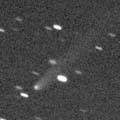
|
It was observed visually as bright as 13 mag from late 2005 to early 2006. It has already faded down to 17.6 mag (Jan. 9, M. Reszelski). It will be fainter than 18 mag soon.
Date(TT) R.A. (2000) Decl. Delta r Elong. m1 Best Time(A, h)
Mar. 15 14 24.58 -0 44.2 6.527 7.305 138 17.9 2:54 (180, 56)
Mar. 22 14 22.65 -0 40.6 6.494 7.339 145 18.0 2:24 (180, 56)
|

|
It was observed bright at 16.5-17 mag from late 2006 to early 2007. However, it is fading after that, although it is getting closer to the sun. Now it is observable in good condition, but very faint at 18.3 mag (Jan. 27, Ken-ichi Kadota). This comet was observed so faint around the perihelion passage in the previous apparition at the discovery. It faded out before the perihelion passage again in this apparition.
Date(TT) R.A. (2000) Decl. Delta r Elong. m1 Best Time(A, h)
Mar. 15 7 26.07 28 51.2 3.720 4.224 114 19.3 19:52 (180, 26)
Mar. 22 7 27.24 28 54.1 3.816 4.222 107 19.4 19:32 (179, 26)
|
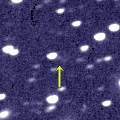
|
Now it is 17.3 mag (Jan. 5, Ken-ichi Kadota). In the previous apparition in 1997, it brightened after the perihelion passage, and observed visually at 13 mag. However, such a brightening did not happen and the comet kept faint in the current apparition. However, now it may be slightly brighter than this ephemeris.
Date(TT) R.A. (2000) Decl. Delta r Elong. m1 Best Time(A, h)
Mar. 15 6 52.87 17 53.1 2.969 3.409 107 19.7 19:43 (173, 37)
Mar. 22 6 56.07 17 57.8 3.080 3.424 101 19.9 19:32 (169, 36)
|
|
![]()
 C/2006 OF2 ( Broughton )
C/2006 OF2 ( Broughton ) C/2008 A1 ( McNaught )
C/2008 A1 ( McNaught ) C/2003 T12 ( SOHO )
C/2003 T12 ( SOHO ) 29P/Schwassmann-Wachmann 1
29P/Schwassmann-Wachmann 1 C/2007 B2 ( Skiff )
C/2007 B2 ( Skiff ) C/2007 G1 ( LINEAR )
C/2007 G1 ( LINEAR ) 19P/Borrelly
19P/Borrelly C/2006 U6 ( Spacewatch )
C/2006 U6 ( Spacewatch ) C/2007 K3 ( Siding Spring )
C/2007 K3 ( Siding Spring ) C/2006 S5 ( Hill )
C/2006 S5 ( Hill ) C/2005 L3 ( McNaught )
C/2005 L3 ( McNaught ) 2005 WY3
2005 WY3 C/2006 W3 ( Christensen )
C/2006 W3 ( Christensen ) C/2006 V1 ( Catalina )
C/2006 V1 ( Catalina ) 192P/2007 T3 ( Shoemaker-Levy 1 )
192P/2007 T3 ( Shoemaker-Levy 1 ) 93P/Lovas 1
93P/Lovas 1 110P/Hartley 3
110P/Hartley 3 124P/Mrkos
124P/Mrkos 79P/du Toit-Hartley
79P/du Toit-Hartley C/2007 M2 ( Catalina )
C/2007 M2 ( Catalina ) 70P/Kojima
70P/Kojima 180P/2006 U3 ( NEAT )
180P/2006 U3 ( NEAT ) 74P/Smirnova-Chernykh
74P/Smirnova-Chernykh 65P/Gunn
65P/Gunn 50P/Arend
50P/Arend C/2007 T5 ( Gibbs )
C/2007 T5 ( Gibbs ) C/2005 S4 ( McNaught )
C/2005 S4 ( McNaught ) C/2002 VQ94 ( LINEAR )
C/2002 VQ94 ( LINEAR ) 197P/2008 E2 ( LINEAR )
197P/2008 E2 ( LINEAR ) C/2007 D1 ( LINEAR )
C/2007 D1 ( LINEAR ) C/2007 Y1 ( LINEAR )
C/2007 Y1 ( LINEAR ) C/2003 WT42 ( LINEAR )
C/2003 WT42 ( LINEAR ) 173P/2005 T1 ( Mueller 5 )
173P/2005 T1 ( Mueller 5 ) 128P/Shoemaker-Holt 1
128P/Shoemaker-Holt 1![]()































